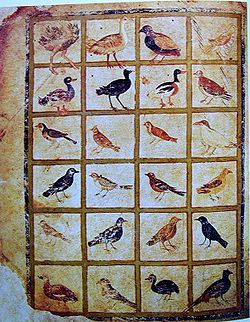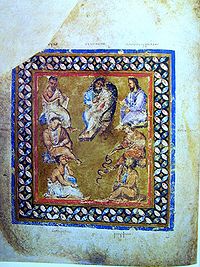
Vienna Dioscurides
Encyclopedia

Illuminated manuscript
An illuminated manuscript is a manuscript in which the text is supplemented by the addition of decoration, such as decorated initials, borders and miniature illustrations...
of De Materia Medica
Materia medica
Materia medica is a Latin medical term for the body of collected knowledge about the therapeutic properties of any substance used for healing . The term 'materia medica' derived from the title of a work by the Ancient Greek physician Pedanius Dioscorides in the 1st century AD, De materia medica libre...
by Dioscorides in Greek. It is an important and rare example of a late antique
Late Antiquity
Late Antiquity is a periodization used by historians to describe the time of transition from Classical Antiquity to the Middle Ages, in both mainland Europe and the Mediterranean world. Precise boundaries for the period are a matter of debate, but noted historian of the period Peter Brown proposed...
scientific text. The 491 vellum
Vellum
Vellum is mammal skin prepared for writing or printing on, to produce single pages, scrolls, codices or books. It is generally smooth and durable, although there are great variations depending on preparation, the quality of the skin and the type of animal used...
folios measure 37 by 30 cm and contain more than 400 pictures of animals and plants, most done in a naturalistic style.
In addition to the text by Dioscorides, the manuscript has appended to it the Carmen de herbis attributed to Rufus
Rufus of Ephesus
Rufus of Ephesus was an ancient Greek physician and author who wrote treatises on dietetics, pathology, anatomy, and patient care. He was to some extent a follower of Hippocrates, although he at times criticized or departed from that author's teachings...
, a paraphrase of an ornithological treatise by a certain Dionysius, usually identified with Dionysius of Philadelphia, and a paraphrase of Nicander
Nicander
Nicander of Colophon , Greek poet, physician and grammarian, was born at Claros, , near Colophon, where his family held the hereditary priesthood of Apollo. He flourished under Attalus III of Pergamum.He wrote a number of works both in prose and verse, of which two survive complete...
's treatise on the treatment of snake bites.
The manuscript was created in about 515 and was made for the Byzantine
Byzantine Empire
The Byzantine Empire was the Eastern Roman Empire during the periods of Late Antiquity and the Middle Ages, centred on the capital of Constantinople. Known simply as the Roman Empire or Romania to its inhabitants and neighbours, the Empire was the direct continuation of the Ancient Roman State...
princess Juliana Anicia, the daughter of Emperor Anicius Olybrius
Olybrius
Anicius Olybrius was Western Roman Emperor from April or May 472 to his death. He was in reality a puppet ruler, put on the throne by the Roman general of Germanic descent Ricimer, and was mainly interested in religion, while the actual power was held by Ricimer and his nephew Gundobad.-Family and...
. Although it was originally created as a luxury copy, there is some indication that in later centuries it was used daily as a hospital textbook. It includes some annotations in Arabic
Arabic language
Arabic is a name applied to the descendants of the Classical Arabic language of the 6th century AD, used most prominently in the Quran, the Islamic Holy Book...
.
The manuscript was discovered in Istanbul
Istanbul
Istanbul , historically known as Byzantium and Constantinople , is the largest city of Turkey. Istanbul metropolitan province had 13.26 million people living in it as of December, 2010, which is 18% of Turkey's population and the 3rd largest metropolitan area in Europe after London and...
in the 1560s by the Flemish diplomat Ogier Ghiselin de Busbecq
Ogier Ghiselin de Busbecq
Ogier Ghiselin de Busbecq was a 16th century Flemish writer, herbalist and diplomat in the employ of three generations of Austrian monarchs...
who was in the employ of Emperor Ferdinand I
Ferdinand I, Holy Roman Emperor
Ferdinand I was Holy Roman Emperor from 1558 and king of Bohemia and Hungary from 1526 until his death. Before his accession, he ruled the Austrian hereditary lands of the Habsburgs in the name of his elder brother, Charles V, Holy Roman Emperor.The key events during his reign were the contest...
. The Emperor bought the manuscript and it is now held in the Österreichische Nationalbibliothek in Vienna
Vienna
Vienna is the capital and largest city of the Republic of Austria and one of the nine states of Austria. Vienna is Austria's primary city, with a population of about 1.723 million , and is by far the largest city in Austria, as well as its cultural, economic, and political centre...
. The manuscript was inscribed on UNESCO's
UNESCO
The United Nations Educational, Scientific and Cultural Organization is a specialized agency of the United Nations...
Memory of the World Programme
Memory of the World Programme
UNESCO's Memory of the World Programme is an international initiative launched to safeguard the documentary heritage of humanity against collective amnesia, neglect, the ravages of time and climatic conditions, and willful and deliberate destruction...
Register in 1997 in recognition of its historical significance.
Illustrations
The manuscript has 383 extant full-page illustrations of plants out of the original 435 illustrations. The illustrations fall into two groups. There are those that faithfully follow earlier classical models and present a quite naturalistic illustration of each plant. There are also other illustrations that are more abstract. The majority of the illustrations were painted in a naturalistic style so as to aid a pharmacologist in the recognition of each plant. However, it is believed that these illustrations were made as copies of an earlier herbal and were not drawn from nature.In addition to the illustrations of the text, the manuscript contains several frontispiece
Book frontispiece
A frontispiece is a decorative illustration facing a book's title page. The frontispiece is the verso opposite the recto title page. Elaborate engraved frontispieces were in frequent use, especially in Bibles and in scholarly books, and many are masterpieces of engraving...
s in the form of a series of full-page miniatures. Of special note is the dedication miniature portrait of Anicia Julia on folio 6 verso. (See here.) The manuscript was presented to Anicia out of gratitude for her funding the construction of a church in the suburbs of Constantinople
Constantinople
Constantinople was the capital of the Roman, Eastern Roman, Byzantine, Latin, and Ottoman Empires. Throughout most of the Middle Ages, Constantinople was Europe's largest and wealthiest city.-Names:...
. This portrait is the oldest extant dedication portrait. The portrait has Anicia seated in a ceremonial pose distributing alms. She is flanked by personifications of Magnanimity
Magnanimity
Magnanimity is the virtue of being great of mind and heart. It encompasses, usually, a refusal to be petty, a willingness to face danger, and actions for noble purposes. Its antithesis is pusillanimity...
and Prudence
Prudence
Prudence is the ability to govern and discipline oneself by the use of reason. It is classically considered to be a virtue, and in particular one of the four Cardinal virtues .The word comes from Old French prudence , from Latin...
. At her feet, another personification, labeled "Gratitude of the Arts", kneels. A putto
Putto
A putto is a figure of an infant often depicted as a young male. Putti are defined as chubby, winged or wingless, male child figure in nude. Putti are distinct from cherubim, but some English-speakers confuse them with each other, except that in the plural, "the Cherubim" refers to the biblical...
holds a dedication copy up to Anicia. Anicia and her attendants are enclosed within an eight-point star within a circle all formed of intertwined rope. Within the outer spandrels of the star are putti, done in grisaille
Grisaille
Grisaille is a term for painting executed entirely in monochrome or near-monochrome, usually in shades of grey. It is particularly used in large decorative schemes in imitation of sculpture. Many grisailles in fact include a slightly wider colour range, like the Andrea del Sarto fresco...
, working as masons and carpenters. This miniature is an altogether original creation and, with the inclusion of the personifications and the putti, shows the endurance of the classical tradition in Constantinople, despite the fact that Anicia herself was a pious Christian.
The series of frontispieces in the manuscript begins with two full-page miniatures, each having a group of seven noted pharmacologists. In the second picture (folio 3 verso, see here), the most prominent and only one sitting on a chair is Galen
Galen
Aelius Galenus or Claudius Galenus , better known as Galen of Pergamon , was a prominent Roman physician, surgeon and philosopher...
. He is flanked by three pairs of other physicians, seated on stones or the ground. Closest to Galen are Crateuas
Crateuas
Crateuas may refer to:*Crateuas of Macedon or Craterus, King of Macedon in 399 BC*Crateuas, father of Peithon of Macedon*Crateuas , Greek artist, physician, herbalist, rhizotomist of Mithradates VI, King of Pontus...
and Dioscurides. The second pair are Apollonius Mys
Apollonius (physician)
Apollonius was the name of several physicians in the time of Ancient Greece and Rome:*Apollonius Antiochenus, , was the name of two physicians, father and son, who were born at Antioch, and belonged to the Empiric school. They lived after Serapion of Alexandria, and before Menodotus, and therefore...
and Nicander
Nicander
Nicander of Colophon , Greek poet, physician and grammarian, was born at Claros, , near Colophon, where his family held the hereditary priesthood of Apollo. He flourished under Attalus III of Pergamum.He wrote a number of works both in prose and verse, of which two survive complete...
. Farthest from Galen are Andreas and Rufus
Rufus of Ephesus
Rufus of Ephesus was an ancient Greek physician and author who wrote treatises on dietetics, pathology, anatomy, and patient care. He was to some extent a follower of Hippocrates, although he at times criticized or departed from that author's teachings...
. Each of the figures is a self-contained portrait and was probably modeled on authors' portraits from the various authors' treatises. The seven figures are contained within an elaborate decorated frame. The background is solid gold, which places the figures in an abstract space. This is the earliest known manuscript to use a solid gold background.

Mandrake (plant)
Mandrake is the common name for members of the plant genus Mandragora, particularly the species Mandragora officinarum, belonging to the nightshades family...
root. He is painting from nature. The mandrake root he is looking at is held by the personification of Epinoia (the power of thought). There is architectural background consisting of a colonnade with a central niche.
The paraphrase of the treatise on bird
Bird
Birds are feathered, winged, bipedal, endothermic , egg-laying, vertebrate animals. Around 10,000 living species and 188 families makes them the most speciose class of tetrapod vertebrates. They inhabit ecosystems across the globe, from the Arctic to the Antarctic. Extant birds range in size from...
s by Dionysius is in three books. The first two books have illustrations of the birds inserted into the text columns without frame or background (for example, see here). The third book has 24 birds arranged in a grid on a full-page miniature (see illustration above). The birds portrayed throughout the treatise are of high artistic merit and are faithful to nature in form and color. Most of the birds are easily identifiable. Interestingly, some of the birds contained in the full-page miniature in the third book are not described in the text of the paraphrase. It is probable that these illustrations are based on the illustrations from an older, different treatise, possibly that of Alexander of Myndus
Alexander of Myndus
Alexander of Myndus in Caria was an ancient Greek writer who some believe lived during the 1st century AD but this date is uncertain. He wrote on diverse topics, including zoology and divination...
. This manuscript, however, is the oldest surviving illustrated treatise on birds.

